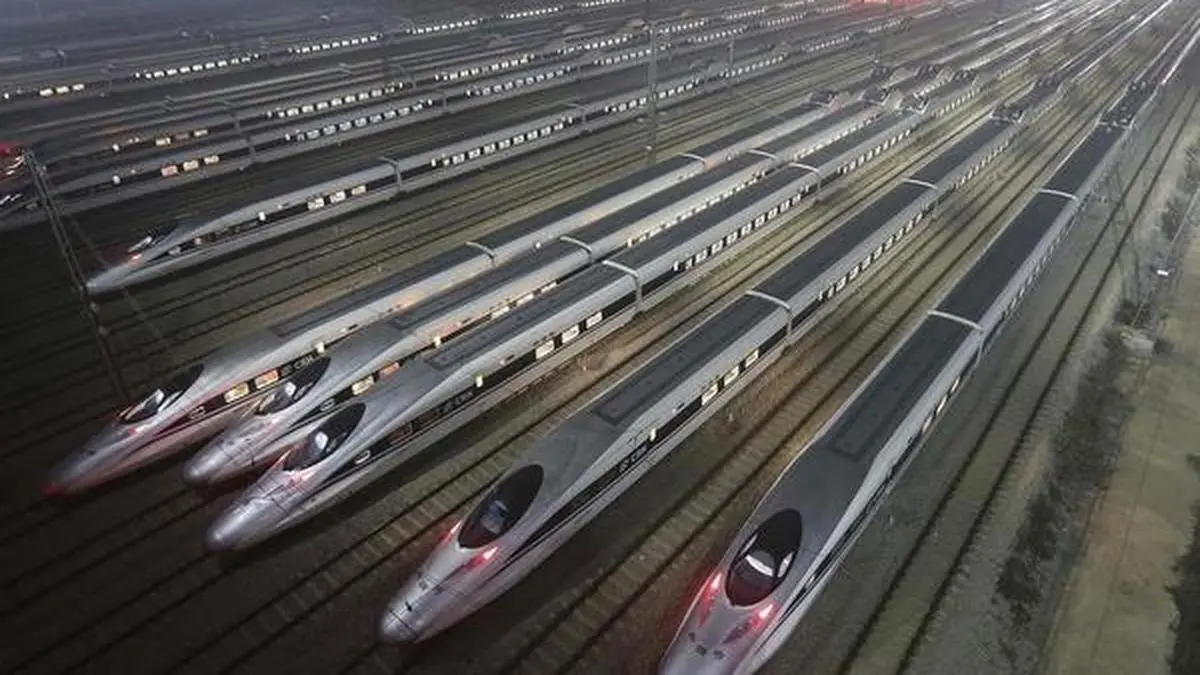Spanish cos eye high speed rail in India
In a recent interview with Mint, Spain’s ambassador to India, Jose Maria Ridao Dominguez, revealed that Spanish transport firms have expressed keen interest in participating in the construction of high-speed railway networks in India. This development highlights the potential for collaboration between the two countries in advancing India’s rail infrastructure.
Ambassador Dominguez emphasized the strong interest shown by Spanish companies with expertise in high-speed rail technology and infrastructure projects. Spain is recognized globally for its efficient and extensive high-speed rail network, and the ambassador’s remarks indicate a willingness to share this expertise with India.
India has been actively exploring opportunities to enhance its railway infrastructure, with a focus on high-speed rail networks to improve connectivity and transportation efficiency. The engagement of Spanish transport firms could bring valuable technical know-how and experience to the Indian rail sector. 
The ambassador’s statement underscores the collaborative spirit between Spain and India, suggesting a mutual interest in fostering partnerships for infrastructure development. The potential involvement of Spanish companies in India’s high-speed rail projects could contribute to the nation’s ambitious plans for modernizing its transportation networks.
As India seeks to upgrade its rail infrastructure to meet the demands of a growing economy, international collaborations and the infusion of advanced technologies become crucial. Spain’s proven track record in high-speed rail construction and operation positions it as a valuable partner for India in achieving its goals for a modern and efficient railway system.
The development also aligns with broader initiatives to strengthen economic and diplomatic ties between Spain and India. The interest expressed by Spanish transport firms signals a positive step toward realizing shared objectives in advancing transportation infrastructure and fostering international cooperation in the realm of rail connectivity.
According to Spain’s ambassador to India, Jose Maria Ridao Dominguez, Spain, boasting the world’s second-largest high-speed train network after China, is keen to explore opportunities for its private sector companies in India’s high-speed rail sector. Ambassador Dominguez specifically mentioned Talgo, a prominent Spanish manufacturer specializing in high-speed passenger trains, as one of the interested parties looking to participate in India’s high-speed rail projects.
The ambassador’s mention of Talgo underscores the interest of Spanish companies with expertise in high-speed rail technology and manufacturing. Talgo, recognized for its innovative train designs and technology, has a proven track record in the development of high-speed trains globally. 
Spain’s wealth of experience in establishing and operating an extensive high-speed rail network positions it as a valuable source of knowledge and technology for India. As India aims to enhance its rail infrastructure, particularly with an emphasis on high-speed connectivity, collaborations with established players like Talgo could contribute significantly to the realization of these ambitions.
The interest of Spanish companies, especially those like Talgo, signals a potential avenue for technology transfer and knowledge-sharing in the realm of high-speed rail. This collaboration could pave the way for the adoption of advanced rail technologies and practices in India, promoting efficiency and sustainability in the country’s transportation sector.
Overall, Spain’s interest in exploring opportunities in India’s high-speed rail sector, coupled with the involvement of companies like Talgo, reflects a positive trajectory in fostering international partnerships for the development of cutting-edge transportation infrastructure in India.
In addition to high-speed rail projects, the defense sector holds a significant focus for Spain, according to Ambassador Jose Maria Ridao Dominguez. Spain’s state-owned defense firm, Navantia, has expressed interest in securing a contract to build six submarines for India under Project 75 (I). This strategic initiative aims to strengthen India’s naval capabilities, and Navantia has entered into a partnership with Larsen and Toubro (L&T) for this endeavor, forming a collaboration that began in April.
The involvement of Navantia and L&T in the bidding process for the submarine contract highlights Spain’s commitment to contributing to India’s defense infrastructure. The collaboration aligns with India’s aspirations to enhance its naval capabilities through the acquisition of advanced submarines.
Navantia, as a seasoned player in the defense industry, brings expertise and technology that could prove beneficial to India’s defense modernization efforts. The partnership with L&T, one of India’s leading engineering and construction conglomerates, further strengthens the collaborative approach in addressing India’s defense requirements.
The pursuit of defense contracts by Spain underscores the diplomatic and strategic importance placed on the bilateral relationship between Spain and India. Collaborative ventures in defense projects contribute not only to India’s national security but also to the technological exchange and mutual development goals of both nations.
The involvement of Navantia and L&T in the bid for Project 75 (I) reflects the growing synergy between the two countries in crucial sectors, reaffirming the potential for deeper cooperation and partnerships that extend beyond the realm of transportation infrastructure.
The Project 75 (I) initiative, representing India’s largest defense acquisition project, emphasizes the collaboration between an Indian bidder and a Foreign Collaborator (FC) for the delivery of six conventional submarines equipped with Air-Independent Propulsion (AIP) and achieving targeted Indigenous Content. The project, valued at over €4.8 billion, is a significant milestone for India’s defense capabilities and is expected to be followed by a 30-year lifecycle sustenance contract of similar value.
Larsen and Toubro (L&T), in collaboration with Spain’s state-owned defense firm Navantia, has entered the competition for this critical defense project. The strategic partnership between L&T and Navantia aligns with the ambitious Strategic Partnership (SP) model of acquisition outlined by the Ministry of Defence.
The incorporation of Air-Independent Propulsion technology in the submarines enhances their operational capabilities, allowing for extended underwater endurance and reduced detectability. The Project 75 (I) initiative underscores India’s commitment to modernizing its naval fleet with advanced and technologically sophisticated submarines.
The bid for Project 75 (I) signifies not only the pursuit of defense contracts but also the implementation of a collaborative model that promotes indigenous content and technological self-reliance. The success of this venture would mark a significant achievement in India’s defense procurement strategy, showcasing the effectiveness of the Strategic Partnership model.
As India strives to bolster its defense infrastructure, partnerships with established global players like Navantia contribute to the transfer of advanced technology and expertise, fostering the growth of indigenous defense capabilities. The emphasis on a 30-year lifecycle sustenance contract further underscores the long-term commitment to maintaining and upgrading the submarines, ensuring their operational efficiency over an extended period.
The prospective deal between India and Spain, involving the construction of six submarines under Project 75 (I), is set to include a comprehensive transfer of technology from Spain’s state-owned defense firm, Navantia. Ambassador Jose Maria Ridao Dominguez confirmed that Navantia, recognized for its expertise in naval technology, is prepared to share its advanced design and engineering capabilities with the Indian partner, ensuring a significant infusion of technological know-how into India’s defense sector.
Navantia intends to base the design of the submarines for Project 75 (I) on its S80 class, a sophisticated and modern submarine series that was launched in 2021. These submarines are currently undergoing sea trials, showcasing the cutting-edge technology and capabilities incorporated into their design. The impending delivery of the S80 class submarine to the Spanish Navy at the end of this month marks a crucial milestone for Navantia and serves as a testament to the company’s commitment to delivering state-of-the-art naval assets.
The transfer of technology from Navantia to the Indian partner is a pivotal aspect of the collaboration, fostering the indigenous development of submarine technology and manufacturing capabilities in India. This approach aligns with India’s broader objectives of achieving self-reliance and technological autonomy in defense production.
The use of Navantia’s S80 class as a reference for the submarine design underscores the adoption of proven and advanced technologies in the Project 75 (I) initiative. The design elements and features incorporated in the S80 class submarines are expected to enhance the operational capabilities and effectiveness of the submarines intended for the Indian Navy.
Overall, the collaboration between India and Spain, facilitated by Navantia’s expertise and technology transfer, signifies a significant step forward in India’s defense modernization efforts. The infusion of advanced naval capabilities through this partnership contributes to India’s pursuit of a robust and self-sufficient defense industry.
In the competition for India’s Project 75 (I) submarine contract, Spain’s Navantia faces competition from Germany’s Thyssenkrupp Marine Systems (TKMS). According to German officials, Thyssenkrupp Marine Systems has been actively engaged with India and is optimistic about the potential decision on the submarine contract.
Despite the competitive landscape, Ambassador Jose Maria Ridao Dominguez expressed confidence in Navantia’s prospects, emphasizing the distinctive propulsion technology of the Spanish submarines. The propulsion technology is a critical aspect of submarine performance, impacting factors such as speed, range, and operational efficiency.
Navantia’s focus on propulsion technology highlights the strategic importance of this component in the bidding process. The unique features and capabilities associated with Navantia’s propulsion technology could serve as a differentiator in the evaluation process, influencing the decision-making criteria for India’s Project 75 (I) submarine acquisition.
As the competition unfolds, the emphasis on technological advantages, including propulsion capabilities, underscores the significance of advanced features in the selection of a submarine partner. Both Navantia and Thyssenkrupp Marine Systems bring their respective strengths to the table, and the decision will likely hinge on a comprehensive evaluation of the submarines’ technical specifications, performance parameters, and associated technologies.
The outcome of the contract award will have implications not only for the participating companies but also for India’s defense capabilities and its pursuit of advanced naval assets. The competition between Navantia and Thyssenkrupp Marine Systems adds a dynamic element to the defense procurement process, with each contender vying to showcase its technological prowess and meet the specific requirements outlined in Project 75 (I).
Airbus Spain has made significant contributions to India’s military capabilities by delivering the first C-295 transport aircraft as part of a larger deal. The contract, signed in 2021, involves the purchase of 56 C-295 aircraft, aiming to replace India’s aging military transport fleet. The deal, valued at ₹21,395 crore, includes plans for the manufacture of 40 aircraft within India.
The delivery of the first C-295 transport aircraft marks a milestone in India’s efforts to modernize its military transport capabilities. The C-295, known for its versatility and adaptability, is expected to enhance India’s logistical and tactical airlift capabilities. The procurement of these aircraft aligns with India’s broader defense modernization initiatives, focusing on acquiring state-of-the-art assets to meet evolving security challenges.
The decision to manufacture a significant portion of the C-295 aircraft within India underscores the commitment to the “Make In India” program, fostering indigenous manufacturing and technology transfer. Collaborative efforts with global aerospace companies, such as Airbus Spain, contribute to building a robust defense industrial base in India.
The C-295 aircraft’s delivery and subsequent production in India exemplify the collaborative approach between international partners and Indian defense entities. The transfer of technology and expertise associated with the C-295 program aligns with India’s goals of achieving self-reliance and developing a competitive defense industry.
As India continues to modernize its military capabilities across various domains, partnerships with global aerospace leaders like Airbus Spain play a vital role in achieving technological advancements and addressing the evolving requirements of the armed forces. The successful implementation of such collaborations contributes to strengthening bilateral ties and fostering mutual growth in the defense sector.






